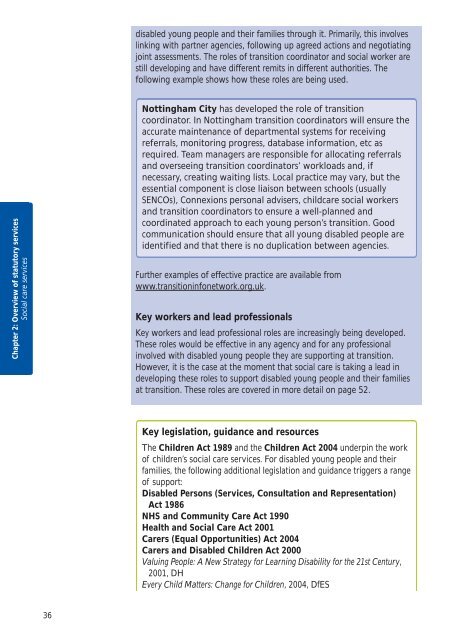A Transition Guide for All Services - Transition Information Network
A Transition Guide for All Services - Transition Information Network
A Transition Guide for All Services - Transition Information Network
- No tags were found...
You also want an ePaper? Increase the reach of your titles
YUMPU automatically turns print PDFs into web optimized ePapers that Google loves.
disabled young people and their families through it. Primarily, this involveslinking with partner agencies, following up agreed actions and negotiatingjoint assessments. The roles of transition coordinator and social worker arestill developing and have different remits in different authorities. Thefollowing example shows how these roles are being used.Chapter 2: Overview of statutory servicesSocial care servicesNottingham City has developed the role of transitioncoordinator. In Nottingham transition coordinators will ensure theaccurate maintenance of departmental systems <strong>for</strong> receivingreferrals, monitoring progress, database in<strong>for</strong>mation, etc asrequired. Team managers are responsible <strong>for</strong> allocating referralsand overseeing transition coordinators’ workloads and, ifnecessary, creating waiting lists. Local practice may vary, but theessential component is close liaison between schools (usuallySENCOs), Connexions personal advisers, childcare social workersand transition coordinators to ensure a well-planned andcoordinated approach to each young person’s transition. Goodcommunication should ensure that all young disabled people areidentified and that there is no duplication between agencies.Further examples of effective practice are available fromwww.transitioninfonetwork.org.uk.Key workers and lead professionalsKey workers and lead professional roles are increasingly being developed.These roles would be effective in any agency and <strong>for</strong> any professionalinvolved with disabled young people they are supporting at transition.However, it is the case at the moment that social care is taking a lead indeveloping these roles to support disabled young people and their familiesat transition. These roles are covered in more detail on page 52.Key legislation, guidance and resourcesThe Children Act 1989 and the Children Act 2004 underpin the workof children’s social care services. For disabled young people and theirfamilies, the following additional legislation and guidance triggers a rangeof support:Disabled Persons (<strong>Services</strong>, Consultation and Representation)Act 1986NHS and Community Care Act 1990Health and Social Care Act 2001Carers (Equal Opportunities) Act 2004Carers and Disabled Children Act 2000Valuing People: A New Strategy <strong>for</strong> Learning Disability <strong>for</strong> the 21st Century,2001, DHEvery Child Matters: Change <strong>for</strong> Children, 2004, DfES36
















